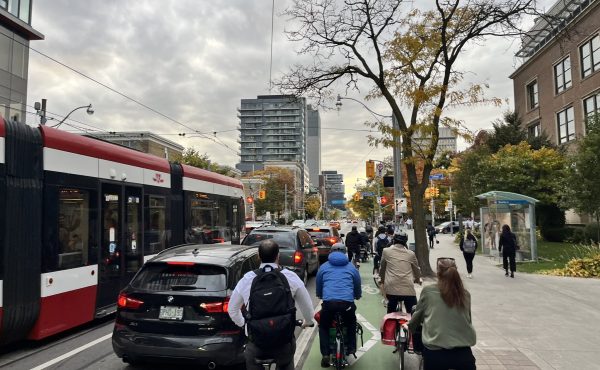
I have just arrived in Rome, and even after just a day and a half of walking around I’ve already formed some strong impressions of Roman public space.
Hills. Rome really is a city of hills, and that means lots of steps. I’ve already noticed, and traversed, several elegant sets of steps. And steps mean places for people to sit, to chat, to bask in the sun, to ponder, to make out. I noticed this even before I’d seen the Spanish Steps, the mother of all steps. Steps make a wonderful contribution to public space, but they have to be WIDE in order to be more than just functional. Think of the steps to the Royal Bank at Yonge and Bloor — desperately ugly, yet people use them because they are wide and located where people go, until the security guards shoo them away. We should have more truly public steps.
Ah yes, making out — Public Displays of Affection are very common in this city, even when it is relatively chilly.
Fountains. The ancient Romans were famous for their aqueducts bringing water to the city, and the tradition of plentiful water still shows. There are fountains everywhere, of all kinds. There are major decorative fountains. There are gorgeous, evocative grotto fountains in the middle of nowhere, seemingly neglected, their sculpures worn away by the water. But once upon a time, fountains were practical — they were how people got their water — and there are still plenty of little practical fountains pouring water where people stop and drink from on their way.
Entrances. Likewise, the ancient Romans loved their triumphal arches, and the Romans have kept up the tradition of grand entranceways to different parts of the city since then to the present. The Romans also built on their past literally as well as metaphorically — all over the city, there are later buildings built on the foundations of Roman buildings. The ages blend and morph together.
Churches. There appears to have been lots of money in Rome in the 17th century, because the part of the city I am in is full of insane, over-ripe baroque churches — sometimes across the street from each other, each more crazily splendid inside than the last, with massive domes, sculputures, frescoes, paintings. They are semi-public — you can wander in even after it’s dark and the church is in shadow and seems closed — I guess it’s too expensive to light them.
Traffic. There has been much talk in pedestrian circles about the Dutch experiment in “Woonerfs”, streets where there is less strict definition between pedestrian and vehicle areas, and the two forms of traffic negotiate on equal terms. Well, all of Rome seems to be one big Woonerf, although the terms are not always equal. There is a constant lack of definition of pedestrian and vehicle spaces — lots of streets without sidewalks, no curbs at the edges of public squares, paved areas that just aren’t defined at all, cobblestone streets barely fit for traffic, but full of parked scooters. The vehicle areas are pressured by pedestrians, and the pedestrian areas allow for vehicles. Some places vehicles dominate, others, pedestrians. As a pedestrian, it can feel like a constant game of chicken.
This, and even my recent trip to Vancouver, also made me realize that every city has its own culture of pedestrianism. For example, in Vancouver, there are zebra crosswalks without lights. In my week there, I never worked out how exactly they worked — were you expected to wait for a break in traffic, or do you just step out and traffic is expected to notice you and stop? It’s even more difficult in Rome, where warning lights don’t work, or seem meaningless, and the traffic is that much more aggressive — and so are the pedestrians. What makes it really complicated (see “game of chicken” above) is that, unlike Vancouver, the vehicles NEVER slow down to indicate they’ve seen you as they approach a crosswalk. You have to just walk into the traffic moving at full speed, knowing it will stop — or, in the case of the many scooters, dodge around you. I have taken to always following crowds of Italians at crosswalks — I figure they instinctively know a good time to cross. It does help that the roads are so confused and crowded that vehicles aren’t moving quite as fast sometimes, but they still move fast. It’s also slightly less intimidating because the average size of vehicles is much smaller.
I realize Toronto’s pedestrian culture is very stereotypically Toronto — more defined and prescribed, with amber lights at every crosswalk, and the expectation that you can cross once you’ve pushed the button. I had friends from England roar with laughter at the little signs that tell you to point when you start to cross — although, in fact, it’s very sensible — in other words, very Toronto.



